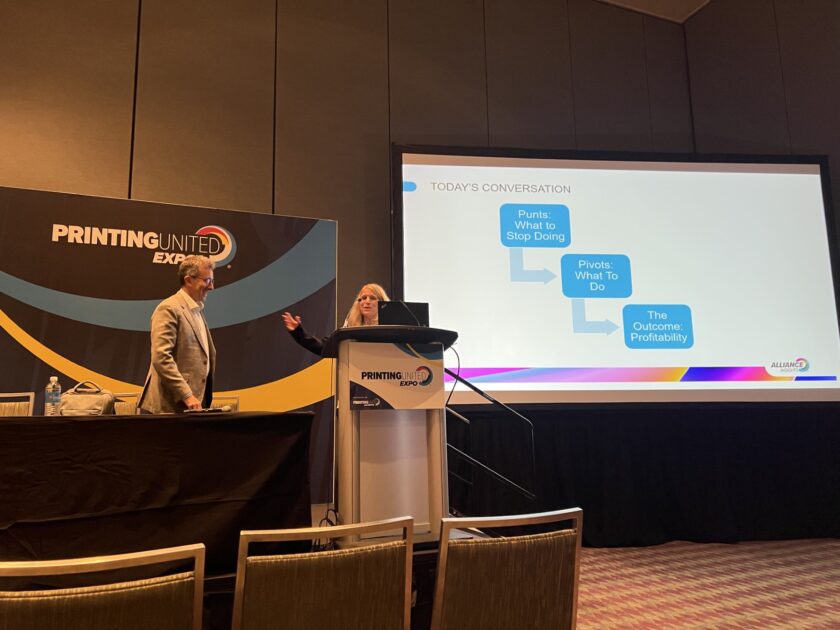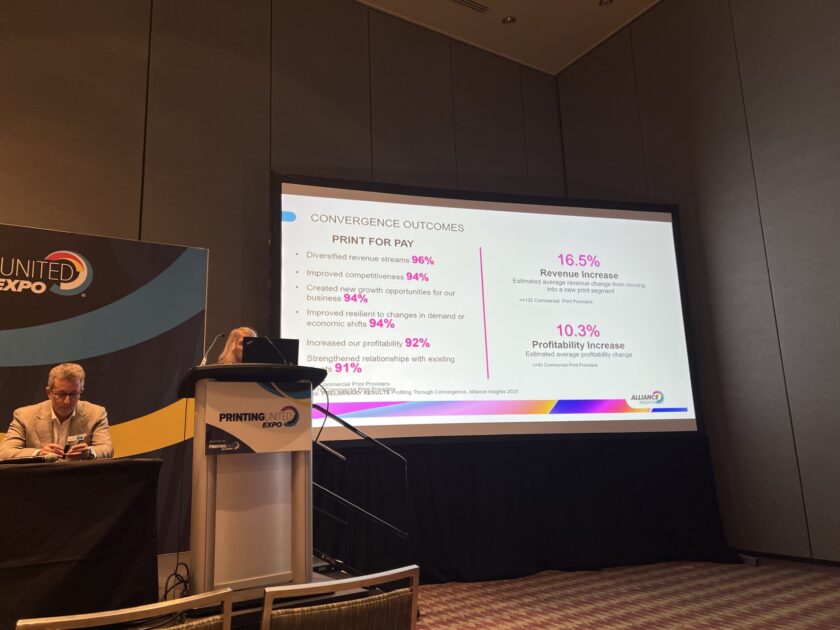Key Takeaways
– Commercial printers must abandon legacy habits like competing solely on price, relying on outdated equipment and acting as order-takers. Instead, they should focus on value-added selling and strategic customer partnerships.
– To stay competitive, printers should invest in automation, online ordering systems and technologies like inkjet and personalization. These tools enhance efficiency, improve ROI and align with evolving customer expectations.
– Diversifying into areas like promotional products, wide-format printing and branded merchandise can offset declining demand in traditional print segments and drive significant revenue growth.
There’s a scene in Moneyball, where Oakland A’s General Manager Billy Beane (played by Brad Pitt) fires the team’s head scout because he feels he’s stuck in the past and the way baseball has “always been.”
Beane throws his hands up and sums up his position, which turned out to be right, simply.
“Adapt or die.”
Baseball works as a pretty solid parallel for the print world. There are those who cling to the way “things have always been and are meant to be” because it worked for them. They can keep on the path even if their team is losing game after game or revenue is dropping year after year.
Or, they could adapt to the times.
That is the crux of what Alliance Insights’ Lisa Cross, principal analyst, and Nathan Safran, vice president of research, focused on in their presentation “Adapting to the New Era of Commercial Printing: Profitability – Pivots, Punts and Plays,” on October 23 at PRINTING United Expo in Orlando.

Punts
Safran defined “punts” in his presentation as “some of the things you’ve got to stop doing.”
The first was what he called the “race to the bottom,” which comes from competing on price alone.
“If you’re competing on price, we have just one quick message for you: Stop,” he said.
Safran and Cross’ advice for adapting in sales was less about learning new techniques and simply shedding bad habits that have lingered as the status quo. This included the idea of “dumping the dinosaurs,” meaning retiring old equipment and manual workflows in favor of “pursuing the future” with more automated systems and more up-to-date equipment that can save time and money in the long run while delivering a higher quality product that customers will want.
Safran also advised print sellers against “chasing every bone,” meaning exhausting oneself with every single potential deal, rather than looking at the bigger picture and evaluating whether a job or customer is worth the time and effort.
“Not every customer, every deal, is worth going after,” he said.
Finally, Safran called for print sellers and printers to stop being simply order-takers.
“Today, it’s all about value-added selling and being a customer’s partner,” he said. He clarified that he doesn’t mean that those who print things like invoices should stop being transactional printers – being a transactional printer is great.
What he recommended was that they stop being only transactional sellers, focusing on the quick sale rather than opportunities to find more value for their customers and truly be a partner.
Pivots
The modern commercial printer, Safran said, can be a vital part of the customer’s brand-building initiative if they take a consultative approach to their job.
“Help your customers and your prospects understand that you’re more than just a printer,” he said, “that you can offer them a variety of capabilities.”
Safran pointed to the data that he and his team compiled for the PRINTING United Alliance State of the Industry report for 2024. In that report, they found that more than three-quarters of participants were expanding their services with programs like data, direct mail and fulfillment.
“About 70%, seven out of 10, are expecting to expand product offerings in the next one to two years,” he said.
In order to pivot from old equipment and printing processes, Cross recommended that they embrace automation and modern innovation – an area they believe many commercial printers are lagging behind.
“One thing we do see in our data is that there is a strong migration to more automated processes, but there are still gaps,” Cross said. “There is still some room to automate operations.”
Cross acknowledged that adopting new technology isn’t always simple. Financial restrictions can get in the way. For those who are able, though, Cross said that technology like inkjet printing and greater personalization capabilities are ways that printers can boost profits long term.
And, she points out that even as postal rates create problems, printers can use mail to actually make money by creating a better product for direct mail rather than a basic one – thus adding more value for the customer and increasing their likelihood to spend more money on the print.
“There’s a lot of impetus to use personalization as a print enhancement as postal rates keep increasing,” Cross said. “They’re using mail less and less, so they’re using personalization to make that piece more effective and meet their return-on-investment goals.”
Capabilities like online ordering, too, can help printers modernize their businesses. It seems strange to say that in 2025, but it’s an area where some printers still need to catch up.
“Web to print has been talked about for at least 20 years, but more and more sellers are offering online portals for their customers,” Cross said. “That’s a good thing, because our communication buyers and print buyers prefer working with print providers who provide online print options.”
In order to stop “chasing every bone,” Cross recommended that printers and distributors use tried-and-true analyses like SWOT (Strengths, Weaknesses, Opportunities and Threats). To modernize even further, Safran recalled a conversation he had recently with a printer who used AI to provide a deeply detailed analysis of his market and aid in creating a SWOT analysis.
The Conversion Opportunity
This is the part of the baseball metaphor where things get murky. For some printers, the idea of adding promotional products might be akin to the Oakland A’s borrowing from the success of football to boost their popularity on the baseball field. The two worlds might feel totally alien to one another, but Safran and Cross pointed out where promo and branded products can be a natural complement to a print business.
Their data found that 62% of participating printers said they are likely to expand into a new print segment in the next year to two years. One of the key reasons for that is that there is a lower barrier for entry to adjacent markets like promo thanks to greater technology and tools, and also the digital world rendering some print products obsolete – or at least creating less demand – where they can supplement that loss with sales in other categories.

Cross provided examples of print firms that have added new services and how that has impacted their business. One, FolgerGraphics, posted sales of $9.24 million for the 2024 fiscal year – a 17% increase year over year. FolgerGraphics had expanded into promotional products, wide-format printing (think signage and displays) and membership cards. Their growth strategy included testing these programs with their partners and planning in-house production based on proven demand.
Other print businesses went the route of acquisition, with Vision Graphics posting a 19% year-over-year sales increase thanks to expanding into related markets like vehicle wraps and retail/brand environments through an acquisition of specialized print firm Queen of Wraps.
This can be like a baseball team – let’s say the 2002 Oakland A’s for conversation’s sake – acquiring players with instant impact like Scott Hatteberg or David Justice, or a pitcher with an unconventional delivery.
At the end of the day, just because something has always been done a certain way does not mean that it’s the right way forever. There is no doubt value in tradition, but rigidity can sink a business in the long term. You can be absolutely certain that your competitors are innovating.
After all, the Boston Red Sox saw what Beane was doing with Sabermetrics in Oakland and used it to win their first World Series in nearly a hundred years, breaking what others called a curse, but might have more realistically been a case of being stuck in their ways and failing to modernize.



